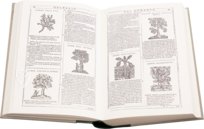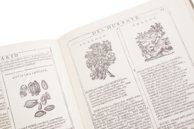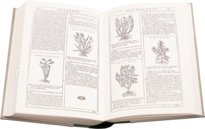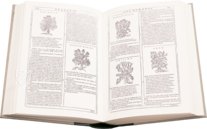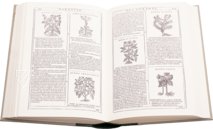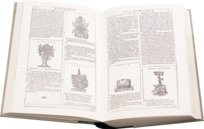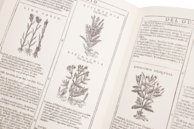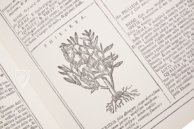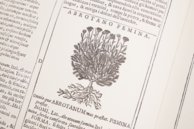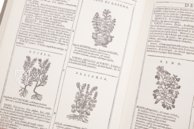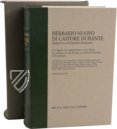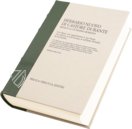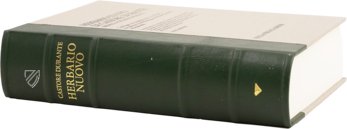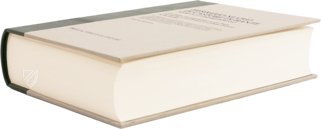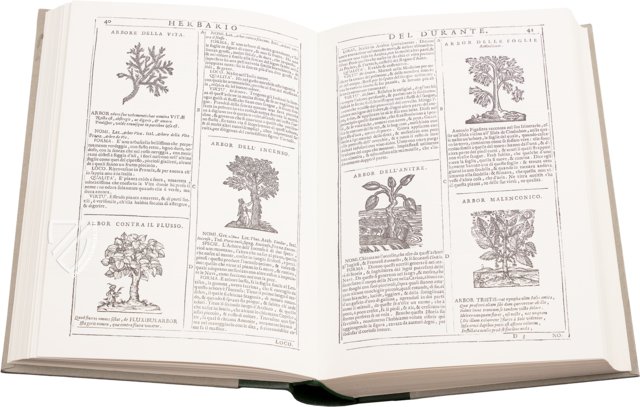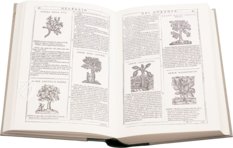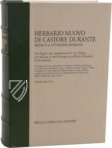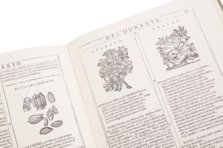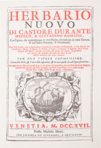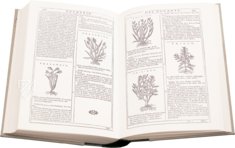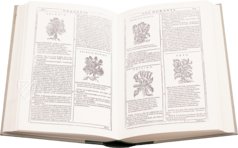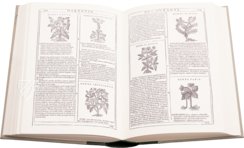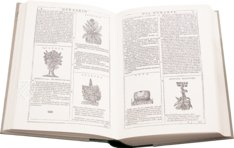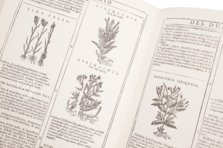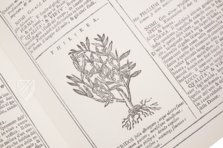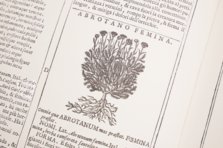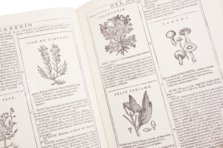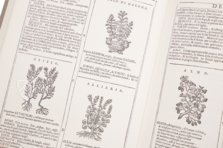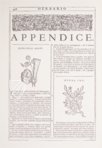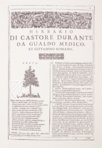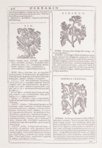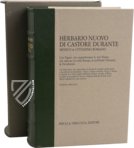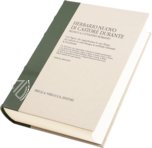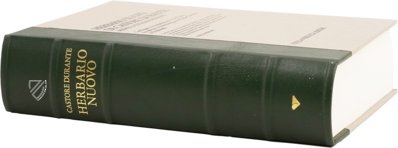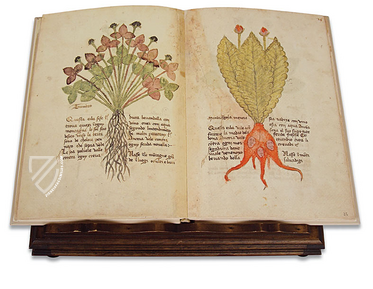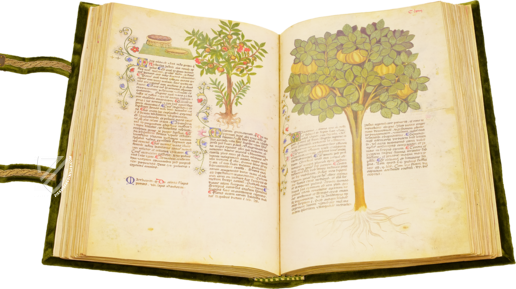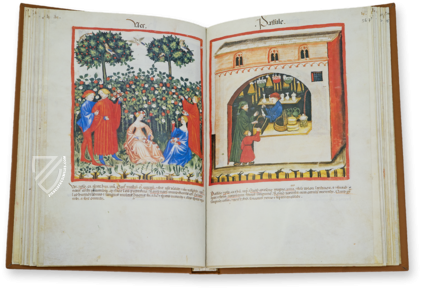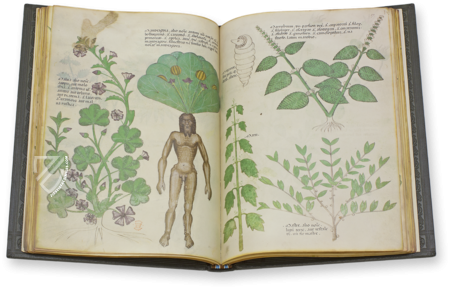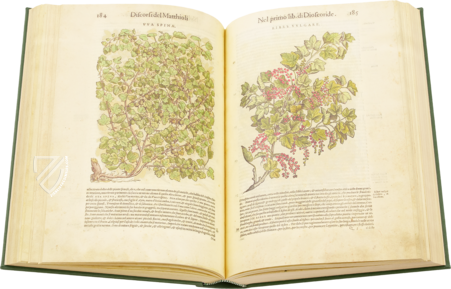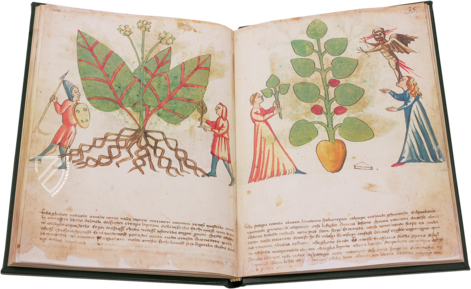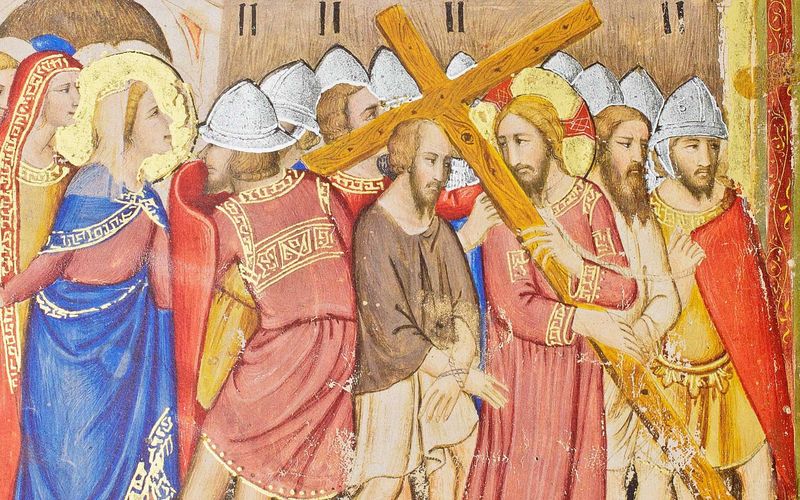New Herbarium by Castore Durante
(1,000€ - 3,000€)
The medicine of the Middle Ages and the early modern age was largely based on healing properties of plants and herbs. One of the most important guidebooks on medieval botany and herbal medicine was composed around 1580 by the Italian Castore Durante. His Herbario Nuovo was continuously revised, expanded, and reprinted until 1718, making it is of great scientific and literary-historical value. The easily understandable yet precise explanations are complemented by realistic illustrations in woodcut technique. The 1717 edition contains numerous revisions and new findings on technical procedures and the new discoveries of exotic animal and plant species. As this publication of 1717 was published in a very limited number of copies, this is a special rarity from the Italian late Middle Ages. With the Herbarium, Durante sought to disseminate scientific facts about medicinal plants and herbs that had existed since antiquity. The astonishingly modern manual contains descriptions of plants, some of which are still valid today, and is still used as a guide in alternative medicine.
New Herbarium by Castore Durante
The Herbario Nuovo, composed by the Italian botanist Castore Durante, is the most comprehensive work on medieval botany and medicine. The text possesses astounding worth, not only scientifically, but also with respect to literary history. It was published for the first time in 1585 and constantly expanded until 1718 and republished many times. The specimen at hand is a 1717 edition, which was only published in a very limited quantity. It is a special rarity among the numerous book treasures of the Italian Middle Ages.
A Modern Edition
The 1717 version of the herbarium contains revisions and new findings, which were still unknown at the time of the first edition. New technical processes and new discoveries of exotic animals and plants, which first occurred after 1585, were included here. With his New Herbarium, the author Durante disseminated scientific facts about efficacious plants and herbs, which already existed since antiquity. In order to clearly understand his medical handbook and also to make it comprehensible for laymen, he used simple but precise descriptions, which were supported by detailed pictures.
The Scientific Durante
The author of the Herbario Nuovo was the Italian Castore Durante. He came into the world in 1529 in Gualdo Tadino in the Italian province of Perugia. The physician and botanist earned the status of “honorary citizen of the city of Rome”. Durante was active as a scholar in the cities of Viterbo and Rome in the name of the Popes Gregory XIII and Sixtus V. It was particularly during his time in Rome that he distinguished himself in his profession. He was one of the most famous authors of scientific and literary manuals in Italy. He died in 1590 in his adopted home of Viterbo.
A Guidebook That Holds True Today
The herbarium describes over 900 species in alphabetical order in their colloquial names. The description is accompanied by their scientific designation in Latin and Greek. In some parts the Arabic, French, Spanish, and German titles are also named. The precise yet comprehensible descriptions in the text were completed by astoundingly realistic illustrations. Many of the plants depicted still exist today and still possess the same medicinal worth that they did in the Middle Ages, The botanical handbook still serves today as a guidebook for alternative medicine.
Codicology
- Alternative Titles
- New Herbal by Castore Durante
Erbario nuovo di Castore Durante
Herbario nuovo di Castore Durante
Neues Herbarium von Castore Durante
Herbario Nuovo - Size / Format
- 640 pages / 33.0 × 23.0 cm
- Origin
- Italy
- Date
- 1717
- Epochs
- Style
- Illustrations
- 900 species presented in alphabetical order with illustrations
- Artist / School
- Castore Durante (1529–90) (author)
New Herbarium by Castore Durante
The star of Bethlehem
The Ornithogalum is also called the Star of Bethlehem, a name that the bulbous plant got from its white star-shaped flowers. According to the legend, the Star of Bethlehem, after having fulfilled its mission of guiding the Three Wise Men and the shepherds to the stable of Bethlehem, burst into countless small pieces and scattered over the meadows and fields. This gave rise to the white flowering stars of the Ornithogaleae, which are still used today as decorative plants in their extensive carpets of flowers. Even if the name Star of Bethlehem appears not until the 17th century, already Castore Durante (1529-90) compares the shape of the open flowers with a star.
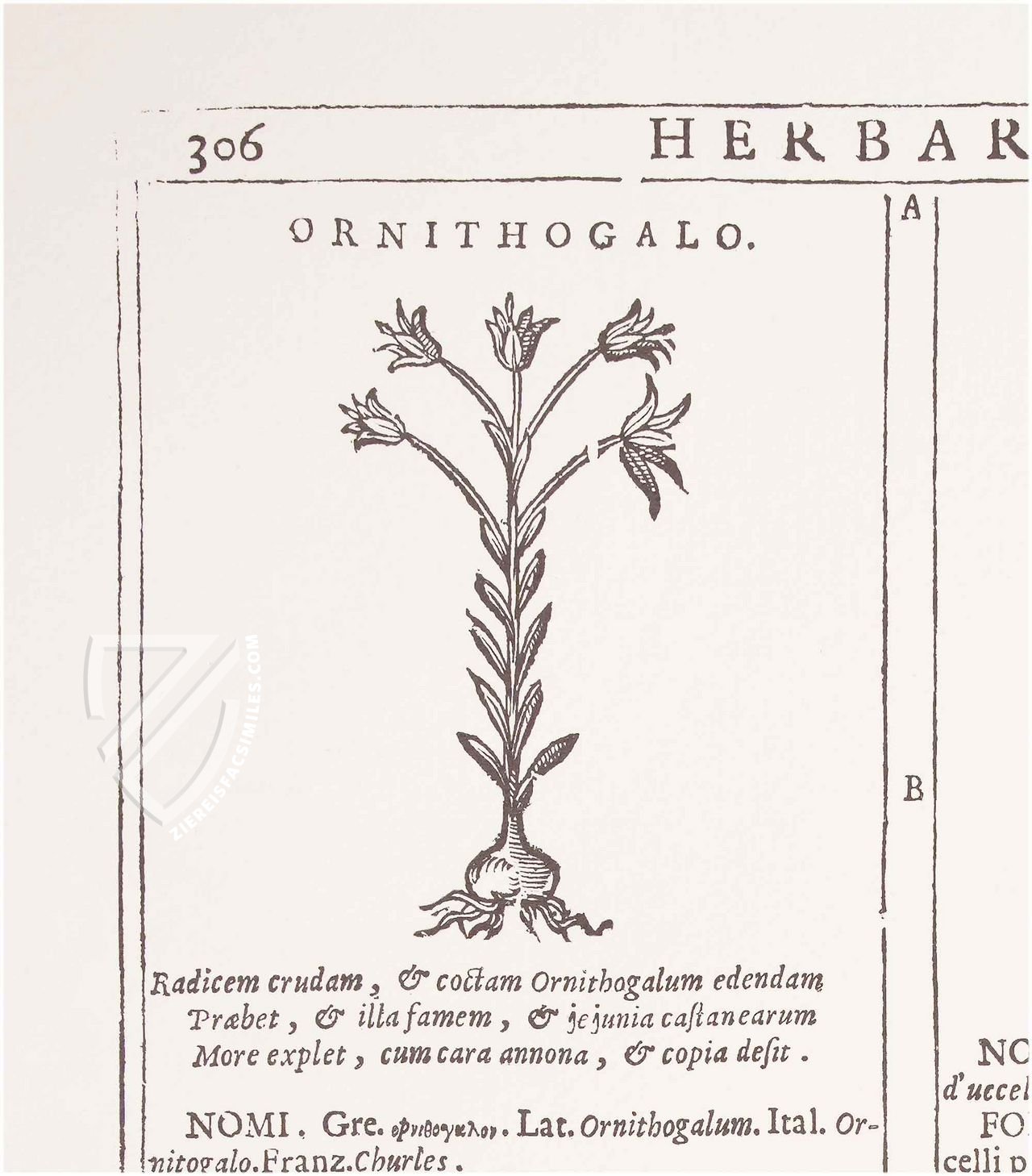
New Herbarium by Castore Durante
Sio and Siringa
The more than 900 species described in the Hebarium are alphabetically listed according to their colloquial names. Structured like a handbook, the entries contain descriptions of the external appearance, occurrence and the various uses. However, the illustrations are the decisive factor, which were not added for aesthetic reasons only but serve as detailed pictures to illustrate the descriptions. The woodcuts so accompany and complete the entries on the respective plant species.
On the left is the precise, yet easy to understand description of the Sium the plant species Merk, which belongs to the umbellifer family and is distributed with about 15 species in Eurasia, North America and Africa. In addition to the information that the plant with its straight stems, crowned as if by an umbrella of white flowers, can be found near water, such as banks, the description contains information on the correct external and internal use of the plant.
The right column contains the plant type of the lilac Siringa (also Syringa), which is often cultivated as an ornamental plant in gardens due to its beautiful appearance and pleasant sweet scent. This is followed by the more popular common lilac Siringa Cerulea, with its numerous small and tightly-seated flowers.

#1 Herbario nuovo di Castore Durante
Language: Italian
(1,000€ - 3,000€)
- Treatises / Secular Books
- Apocalypses / Beatus
- Astronomy / Astrology
- Bestiaries
- Bibles / Gospels
- Chronicles / History / Law
- Geography / Maps
- Saints' Lives
- Islam / Oriental
- Judaism / Hebrew
- Single Leaf Collections
- Leonardo da Vinci
- Literature / Poetry
- Liturgical Manuscripts
- Medicine / Botany / Alchemy
- Music
- Mythology / Prophecies
- Psalters
- Other Religious Books
- Games / Hunting
- Private Devotion Books
- Other Genres
- Afghanistan
- Armenia
- Austria
- Belgium
- Belize
- Bosnia and Herzegovina
- China
- Colombia
- Costa Rica
- Croatia
- Cyprus
- Czech Republic
- Denmark
- Egypt
- El Salvador
- Ethiopia
- France
- Germany
- Greece
- Guatemala
- Honduras
- Hungary
- India
- Iran
- Iraq
- Israel
- Italy
- Japan
- Jordan
- Kazakhstan
- Kyrgyzstan
- Lebanon
- Liechtenstein
- Luxembourg
- Mexico
- Morocco
- Netherlands
- Palestine
- Panama
- Peru
- Poland
- Portugal
- Romania
- Russia
- Serbia
- Spain
- Sri Lanka
- Sweden
- Switzerland
- Syria
- Tajikistan
- Turkey
- Turkmenistan
- Ukraine
- United Kingdom
- United States
- Uzbekistan
- Vatican City
- A. Oosthoek, van Holkema & Warendorf
- Aboca Museum
- Ajuntament de Valencia
- Akademie Verlag
- Akademische Druck- u. Verlagsanstalt (ADEVA)
- Aldo Ausilio Editore - Bottega d’Erasmo
- Alecto Historical Editions
- Alkuin Verlag
- Almqvist & Wiksell
- Amilcare Pizzi
- Andreas & Andreas Verlagsbuchhandlung
- Archa 90
- Archiv Verlag
- Archivi Edizioni
- Arnold Verlag
- ARS
- Ars Magna
- ArtCodex
- AyN Ediciones
- Azimuth Editions
- Badenia Verlag
- Bärenreiter-Verlag
- Belser Verlag
- Belser Verlag / WK Wertkontor
- Benziger Verlag
- Bernardinum Wydawnictwo
- BiblioGemma
- Biblioteca Apostolica Vaticana (Vaticanstadt, Vaticanstadt)
- Bibliotheca Palatina Faksimile Verlag
- Bibliotheca Rara
- Boydell & Brewer
- Bramante Edizioni
- Bredius Genootschap
- Brepols Publishers
- British Library
- C. Weckesser
- Caixa Catalunya
- Canesi
- CAPSA, Ars Scriptoria
- Caratzas Brothers, Publishers
- Carus Verlag
- Casamassima Libri
- Centrum Cartographie Verlag GmbH
- Chavane Verlag
- Christian Brandstätter Verlag
- Circulo Cientifico
- Club Bibliófilo Versol
- Club du Livre
- CM Editores
- Collegium Graphicum
- Collezione Apocrifa Da Vinci
- Comissão Nacional para as Comemorações dos Descobrimentos Portugueses
- Coron Verlag
- Corvina
- CTHS
- D. S. Brewer
- Damon
- De Agostini/UTET
- De Nederlandsche Boekhandel
- De Schutter
- Deuschle & Stemmle
- Deutscher Verlag für Kunstwissenschaft
- DIAMM
- Droz
- E. Schreiber Graphische Kunstanstalten
- Ediciones Boreal
- Ediciones Grial
- Ediclube
- Edições Inapa
- Edilan
- Editalia
- Edition Deuschle
- Edition Georg Popp
- Edition Leipzig
- Edition Libri Illustri
- Editiones Reales Sitios S. L.
- Éditions de l'Oiseau Lyre
- Editions Medicina Rara
- Editorial Casariego
- Editorial Mintzoa
- Editrice Antenore
- Editrice Velar
- Edizioni Edison
- Egeria, S.L.
- Eikon Editores
- Electa
- Emery Walker Limited
- Enciclopèdia Catalana
- Eos-Verlag
- Ephesus Publishing
- Ernst Battenberg
- Eugrammia Press
- Extraordinary Editions
- Fackelverlag
- Facsimila Art & Edition
- Facsimile Editions Ltd.
- Facsimilia Art & Edition Ebert KG
- Faksimile Verlag
- Feuermann Verlag
- Folger Shakespeare Library
- Franco Cosimo Panini Editore
- Friedrich Wittig Verlag
- Fundación Hullera Vasco-Leonesa
- G. Braziller
- Gabriele Mazzotta Editore
- Gebr. Mann Verlag
- Gesellschaft für graphische Industrie
- Getty Research Institute
- Giovanni Domenico de Rossi
- Giunti Editore
- Graffiti
- Grafica European Center of Fine Arts
- Guido Pressler
- Guillermo Blazquez
- Gustav Kiepenheuer
- H. N. Abrams
- Harrassowitz
- Harvard University Press
- Helikon
- Hendrickson Publishers
- Henning Oppermann
- Herder Verlag
- Hes & De Graaf Publishers
- Hoepli
- Holbein-Verlag
- Houghton Library
- Hugo Schmidt Verlag
- Idion Verlag
- Il Bulino, edizioni d'arte
- ILte
- Imago
- Insel Verlag
- Insel-Verlag Anton Kippenberger
- Instituto de Estudios Altoaragoneses
- Instituto Nacional de Antropología e Historia
- Introligatornia Budnik Jerzy
- Istituto dell'Enciclopedia Italiana - Treccani
- Istituto Ellenico di Studi Bizantini e Postbizantini
- Istituto Geografico De Agostini
- Istituto Poligrafico e Zecca dello Stato
- Italarte Art Establishments
- Jan Thorbecke Verlag
- Johnson Reprint Corporation
- Josef Stocker
- Josef Stocker-Schmid
- Jugoslavija
- Karl W. Hiersemann
- Kasper Straube
- Kaydeda Ediciones
- Kindler Verlag / Coron Verlag
- Kodansha International Ltd.
- Konrad Kölbl Verlag
- Kurt Wolff Verlag
- La Liberia dello Stato
- La Linea Editrice
- La Meta Editore
- Lambert Schneider
- Landeskreditbank Baden-Württemberg
- Leo S. Olschki
- Les Incunables
- Liber Artis
- Library of Congress
- Libreria Musicale Italiana
- Lichtdruck
- Lito Immagine Editore
- Lumen Artis
- Lund Humphries
- M. Moleiro Editor
- Maison des Sciences de l'homme et de la société de Poitiers
- Manuscriptum
- Martinus Nijhoff
- Maruzen-Yushodo Co. Ltd.
- MASA
- Massada Publishers
- McGraw-Hill
- Metropolitan Museum of Art
- Militos
- Millennium Liber
- Müller & Schindler
- Nahar - Stavit
- Nahar and Steimatzky
- National Library of Wales
- Neri Pozza
- Nova Charta
- Oceanum Verlag
- Odeon
- Orbis Mediaevalis
- Orbis Pictus
- Österreichische Staatsdruckerei
- Oxford University Press
- Pageant Books
- Parzellers Buchverlag
- Patrimonio Ediciones
- Pattloch Verlag
- PIAF
- Pieper Verlag
- Plon-Nourrit et cie
- Poligrafiche Bolis
- Presses Universitaires de Strasbourg
- Prestel Verlag
- Princeton University Press
- Prisma Verlag
- Priuli & Verlucca, editori
- Pro Sport Verlag
- Propyläen Verlag
- Pytheas Books
- Quaternio Verlag Luzern
- Reales Sitios
- Recht-Verlag
- Reichert Verlag
- Reichsdruckerei
- Reprint Verlag
- Riehn & Reusch
- Roberto Vattori Editore
- Rosenkilde and Bagger
- Roxburghe Club
- Salerno Editrice
- Saltellus Press
- Sandoz
- Sarajevo Svjetlost
- Schöck ArtPrint Kft.
- Schulsinger Brothers
- Scolar Press
- Scrinium
- Scripta Maneant
- Scriptorium
- Shazar
- Siloé, arte y bibliofilia
- SISMEL - Edizioni del Galluzzo
- Sociedad Mexicana de Antropología
- Société des Bibliophiles & Iconophiles de Belgique
- Soncin Publishing
- Sorli Ediciones
- Stainer and Bell
- Studer
- Styria Verlag
- Sumptibus Pragopress
- Szegedi Tudomànyegyetem
- Taberna Libraria
- Tarshish Books
- Taschen
- Tempus Libri
- Testimonio Compañía Editorial
- Thames and Hudson
- The Clear Vue Publishing Partnership Limited
- The Facsimile Codex
- The Folio Society
- The Marquess of Normanby
- The Richard III and Yorkist History Trust
- Tip.Le.Co
- TouchArt
- TREC Publishing House
- TRI Publishing Co.
- Trident Editore
- Tuliba Collection
- Typis Regiae Officinae Polygraphicae
- Union Verlag Berlin
- Universidad de Granada
- University of California Press
- University of Chicago Press
- Urs Graf
- Vallecchi
- Van Wijnen
- VCH, Acta Humaniora
- VDI Verlag
- VEB Deutscher Verlag für Musik
- Verlag Anton Pustet / Andreas Verlag
- Verlag Bibliophile Drucke Josef Stocker
- Verlag der Münchner Drucke
- Verlag für Regionalgeschichte
- Verlag Styria
- Vicent Garcia Editores
- W. Turnowski Ltd.
- W. Turnowsky
- Waanders Printers
- Wiener Mechitharisten-Congregation (Wien, Österreich)
- Wissenschaftliche Buchgesellschaft
- Wissenschaftliche Verlagsgesellschaft
- Wydawnictwo Dolnoslaskie
- Xuntanza Editorial
- Zakład Narodowy
- Zollikofer AG




